Research on Evaluation of the Carbon Dioxide Sequestration Potential in Saline Aquifers in the Qiongdongnan–Yinggehai Basin
Abstract
1. Introduction
2. Evaluation Method for Carbon Sequestration Potential in Saline Aquifers
2.1. Division of Evaluation Levels at Present
2.2. Calculation Methods
- (1)
- Main Calculation Methods for Sequestration Potential
- (2)
- Selection of Sequestration Potential Evaluation Methods
3. Calculation Model and Parameter Selection
3.1. Sequestration Potential Calculation Model
3.2. Parameter Acquisition and Processing Methods
3.3. Calculation of the Sequestration Potential
4. Saline Aquifer Carbon Sequestration Suitability Evaluation
4.1. Necessary Indicators
4.2. Key Indicators
5. Results of Carbon Sequestration Potential Evaluation in Saline Aquifers
5.1. Carbon Sequestration Potential and Suitability Evaluation of the Yinggehai Basin
- (1)
- Geological Characteristics of Carbon Sequestration
- (2)
- Results of Carbon Sequestration Potential and Suitability Evaluation
5.2. Carbon Sequestration Potential and Suitability Evaluation of the Qiongdongnan Basin
- (1)
- Geological Characteristics for Carbon Sequestration
- (2)
- Results of Carbon Sequestration Potential and Suitability Evaluation
6. Conclusions
Author Contributions
Funding
Data Availability Statement
Conflicts of Interest
References
- Baker, E.; Chon, H.; Keisler, J. Carbon capture and storage: Combining economic analysis with expert elicitations to inform climate policy. Clim. Chang. 2009, 96, 379–408. [Google Scholar] [CrossRef]
- Haszeldine, R.S. Carbon capture and storage: How green can black be? Science 2009, 325, 1647–1652. [Google Scholar] [CrossRef] [PubMed]
- Luo, J.; Xie, Y.; Hou, M.Z.; Xiong, Y.; Wu, X.; Lüddeke, C.; Huang, L. Advances in subsea carbon dioxide utilization and storage. Energy Rev. 2023, 2, 100016. [Google Scholar] [CrossRef]
- Bashir, A.; Ali, M.; Patil, S.; Aljawad, M.S.; Mahmoud, M.; Al-Shehri, D.; Hoteit, H.; Kamal, M.S. Comprehensive review of CO2 geological storage: Exploring principles, mechanisms, and prospects. Earth-Sci. Rev. 2024, 249, 104672. [Google Scholar] [CrossRef]
- Matter, J.; Kelemen, P. Permanent storage of carbon dioxide in geological reservoirs by mineral carbonation. Nat. Geosci 2009, 2, 837–841. [Google Scholar] [CrossRef]
- Bauer, S.; Class, H.; Ebert, M.; Gotize, H.; Holzheid, A.; Kolditz, O.; Rosenbaum, S.; Rabel, W.; Schafer, D.; Dahmke, A. Modeling, parameterization and evaluation of monitoring methods for CO2 storage in deep saline formations: The CO2-MoPa project. Environ. Earth Sci. 2012, 67, 351–367. [Google Scholar] [CrossRef]
- Bachu, S. Review of CO2 storage efficiency in deep saline aquifers. Int. J. Greenh. Gas Control 2015, 40, 188–202. [Google Scholar] [CrossRef]
- Kovscek, A.R.; Wang, Y. Geologic storage of carbon dioxide and enhanced oil recovery. i. uncertainty quantification employing a streamline based proxy for reservoir flow simulation. Energy Convers. Manag. 2005, 46, 1920–1940. [Google Scholar] [CrossRef]
- Adu, E.; Zhang, Y.; Liu, D. Current situation of carbon dioxide capture, storage, and enhanced oil recovery in the oil and gas industry. Can. J. Chem. Eng. 2018, 97, 1048–1076. [Google Scholar] [CrossRef]
- Ning, W.; Zunsheng, J.; Kevin, E.; Ku, A.Y.; Shengnan, L.; Richard, M.; Li, X. Decarbonizing the coal-fired power sector in china via carbon capture, geological utilization, and storage technology. Environ. Sci. Technol. 2021, 55, 13164–13173. [Google Scholar] [CrossRef]
- Zhang, L.; Song, Y.; Shi, J.; Shen, Q.; Deng, H.U.; Gao, Q.; Chen, W.; Kow, K.; Pang, C.; Sun, N.; et al. Frontiers of CO2 capture and utilization (ccu) towards carbon neutrality. Adv. Atmos. Sci. 2022, 39, 1252–1270. [Google Scholar] [CrossRef]
- Global CCS Institute. Globa Status of CCS 2023—eport & Executive Summary. 2023. Available online: https://www.globalccsinstitute.com/resources/publications-reports-research/global-status-of-ccs-2023-executive-summary/ (accessed on 10 June 2024).
- Zhang, L.; Li, D.X.; Ezekiel, J.; Zhang, W.D.; Mi, H.G.; Ren, S.R. CO2 geological storage into a lateral aquifer of an offshore gas field in the south china sea: Storage safety and project design. Front. Earth Sci. 2015, 9, 286–299. [Google Scholar] [CrossRef]
- Baines, S.J.; Worden, R.H. Geological storage of carbon dioxide. Rud.-Geološko-Naft. Zb. 2004, 28, 9–22. [Google Scholar] [CrossRef]
- Leung, D.Y.C.; Caramanna, G.; Maroto-Valer, M.M. An overview of current status of carbon dioxide capture and storage technologies. Renew. Sustain. Energy Rev. 2014, 39, 426–443. [Google Scholar] [CrossRef]
- Li, L.; Zhao, N.; Wei, W.; Sun, Y. A review of research progress on CO2 capture, storage, and utilization in chinese academy of sciences. Fuel 2013, 108, 112–130. [Google Scholar] [CrossRef]
- Zhang, L.; Ezekiel, J.; Li, D.; Pei, J.; Ren, S. Potential assessment of CO2 injection for heat mining and geological storage in geothermal reservoirs of china. Appl. Energy 2014, 122, 237–246. [Google Scholar] [CrossRef]
- Gibbins, J.; Chalmers, H. Carbon capture and storage. energy policy. Energy Policy 2008, 36, 4317–4322. [Google Scholar] [CrossRef]
- Zhang, X.; Fan, J.L.; Wei, Y.M. Technology roadmap study on carbon capture, utilization and storage in China. Energy Policy 2013, 59, 536–550. [Google Scholar] [CrossRef]
- Goodman, A.; Bromhal, G.; Strazisar, B.; Rodosta, T.; Guthrie, W.F.; Allend, D. Comparison of methods for geologic storage of carbon dioxide in saline formations. Int. J. Greenh. Gas Control 2013, 18, 329–342. [Google Scholar] [CrossRef]
- Diao, Y.J.; Liu, T.; Wei, N.; Ma, X.; Jin, X.L.; Fu, L. Classification and assessment methodology of carbon dioxide geological storage in deep saline aquifers. Geol. China 2023, 50, 943–951. [Google Scholar] [CrossRef]
- Szulczewski, M.L.; MacMinn, C.W.; Herzog, H.J.; Juanes, R. Lifetime of carbon capture and storage as a climate-change mitigation technology. Proc. Natl. Acad. Sci. USA 2012, 109, 5185–5189. [Google Scholar] [CrossRef]
- Zhou, Q.; Birkholzer, J.T.; Tsang, C.-F.; Rutqvist, J. A method for quick assessment of CO2 storage capacity in closed and semi-closed saline formation. Greenh. Gas Control 2008, 2, 626–639. [Google Scholar] [CrossRef]
- Shen, P.; Liao, X.; Liu, Q. Methodology for estimation of CO2 storage capacity in reservoirs. Pet. Explor. Dev. 2009, 36, 216–220. [Google Scholar] [CrossRef]
- Brennan, S.T.; Burruss, R.C.; Merrill, M.D.; Freeman, P.A.; Ruppert, L.F. A Probabilistic Assessment Methodology for the Evaluation of Geologic Carbon Dioxide Storage; Open File Report 1127; U. S. Geological Survey: Sunrise Valley Drive Reston, VA, USA, 2010; pp. 1–39. Available online: https://www.researchgate.net/publication/262802350_A_Probabilistic_Assessment_Methodology_for_the_Evaluation_of_Geologic_Carbon_Dioxide_Storage (accessed on 10 June 2024).
- US-DOE-NETL. Carbon Sequestration Atlas of the United State and Canada, 2nd ed.; U.S. Deparment of Energy—National Energy Technology Laboratory—Office of Fossil Energy: Albany, OR, USA, 2008. Available online: http://www.netl.doe.gov/technologies/carbonseq/refshelf/atlas/ (accessed on 10 June 2024).
- IEA-GHG. Development of Storage Coefficients for CO2 Storage in Deep Saline Formations; IEA Greeen house Gas R&D Programme (IEA-GHG), Report Number 2009/13; IEA-GHG: Cheltenham, UK, 2009; Available online: https://www.globalccsinstitute.com/resources/publications-reports-research/development-of-storage-coefficients-for-carbon-dioxide-storage-in-deep-saline-formations/ (accessed on 10 June 2024).
- Gorecki, C.D.; Sorensen, J.A.; Bremer, J.M.; Ayash, S.C.; Harju, J.A. Development of Storage Coefficients for Carbon Dioxide Storage in Deep Saline Formations. In Proceedings of the SPE International Conference on CO2 Capture, Storage, and Utilization, San Diego, CA, USA, 2–4 November 2009. [Google Scholar] [CrossRef]
- Goodman, A.; Hakala, A.; Bromhal, G.; Deel, D.; Rodosta, T.; Frailey, S.; Small, M.; Allen, D.; Romanov, V.; Fazio, J.; et al. U.S. DOE methodology for the development of geologic storage potential for carbon dioxide at the national and regional scale. Int. J. Greenh. Gas Control 2011, 5, 952–965. [Google Scholar] [CrossRef]
- Anwar, S.; Carroll, J.J. Carbon Dioxide Thermodynamic Properties Handbook: Covering Temperatures from −20 ° to 250 °C and Pressures up to 1000 Bar, 2nd ed.; Wiley: West Maitland, FL, USA, 2016. [Google Scholar] [CrossRef]
- Cai, B.; Li, Q.; Liu, G.; Liu, L.; Jin, T.; Shi, H. Environmental concern-based site screening of carbon dioxide geological storage in China. Sci. Rep. 2017, 7, 7598. [Google Scholar] [CrossRef] [PubMed]
- Mia, Z.; Wang, F.; Yang, Y.; Wang, F.; Hua, T.; Tian, H.; Tian, A. Evaluation of the potentiality and suitability for CO2 geological storage in the Junggar Basin, northwestern China. Int. J. Greenh. Gas Control 2018, 78, 62–72. [Google Scholar] [CrossRef]
- Bachu, S. Screening and ranking of sedimentary basins for sequestration of CO2 in geological media in response to climate change. Environ. Geol. 2003, 44, 277–289. [Google Scholar] [CrossRef]
- Anthonsen, K.L.; Aagaard, P.; Bergmo, P.E.S.; Erlström, M.; Fareide, J.I.; Gislason, S.R.; Mortensen, G.M.; Snæbjörnsdottir, S.Ó. CO2 storage potential in the Nordic region. Energy Procedia 2013, 37, 5080–5092. [Google Scholar] [CrossRef]
- Vangkilde-Pedersen, A.; Anghe, A.; Zivkovic, A. Wp2 Report—Storage Capacity. eu Geocapacity Project—Assessing European Capacity for Geological Storage of Carbon Dioxide. 2009. Available online: https://www.researchgate.net/publication/262688927_WP2_Report_-_Storage_capacity_EU_GeoCapacity_project_-_Assessing_European_Capacity_for_Geological_Storage_of_Carbon_Dioxide (accessed on 10 June 2024).
- Oldenburg, C.M. Health, Safety, and Environmental Screening and Ranking Framework for Geologic CO2 Storage Site Selection; Lawrence Berkeley National Laboratory: Berkeley, CA, USA, 2005. [Google Scholar] [CrossRef]
- Huo, C.L. Study on the Potential Evaluation and the Storage Areas of the Carbon Dioxide Seabed Storage in Offshore China. Ph.D. Dissertation, Dalian Maritime University, Dalian, China, 2014. [Google Scholar]
- He, J.; Zhang, W.; Lu, Z. Seepage system of oil-gas and its exploration in Yinggehai Basin located at northwest of South China Sea. J. Nat. Gas Geosci. 2017, 2, 29–41. [Google Scholar] [CrossRef]
- Zhu, Y.; Sun, L.; Hao, F.; Tu, L. Geochemical composition and origin of Tertiary oils in the Yinggehai and Qiongdongnan Basins, offshore South China Sea. Mar. Pet. Geol. 2018, 96, 139–153. [Google Scholar] [CrossRef]
- Zhao, J.; Li, J.; Xu, Z. Advances in the origin of overpressures in sedimentary basins. Pet. Res. 2018, 3, 1–24. [Google Scholar] [CrossRef]
- Zhang, G.C.; Zhang, Y.; Shen, H.; He, Y. An analysis of natural gas exploration potential in the Qiongdongnan Basin by use of the theory of “joint control of source rocks and geothermal heat”. Nat. Gas Ind. B 2014, 1, 41–50. [Google Scholar] [CrossRef][Green Version]
- Yu, J.; Pei, J.; Xu, J. New insight into oil and gas exploration in Miocene and Late Oligocene strata in Qiongdongnan basin. J. Earth Sci. 2009, 20, 811–823. [Google Scholar] [CrossRef]
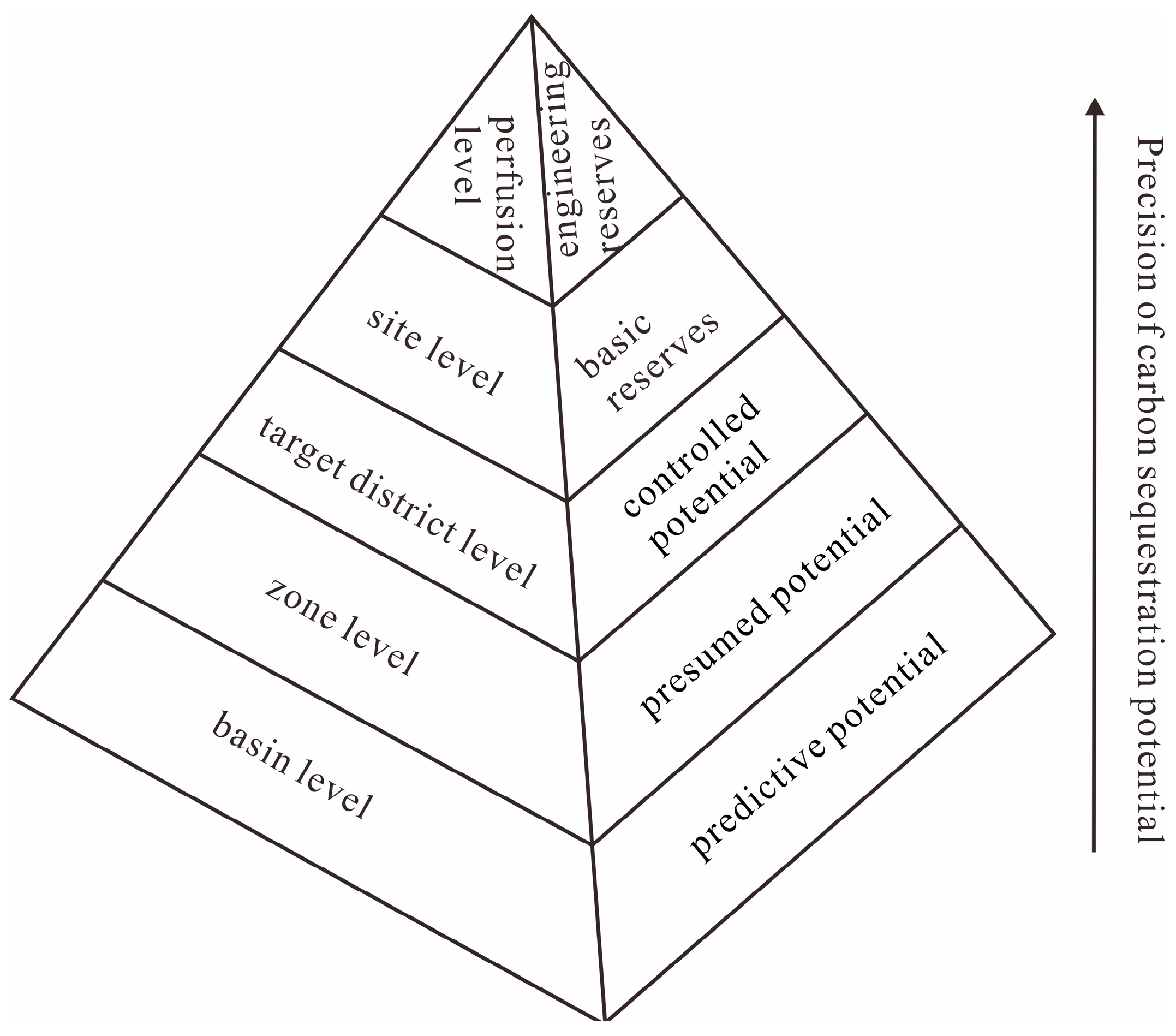

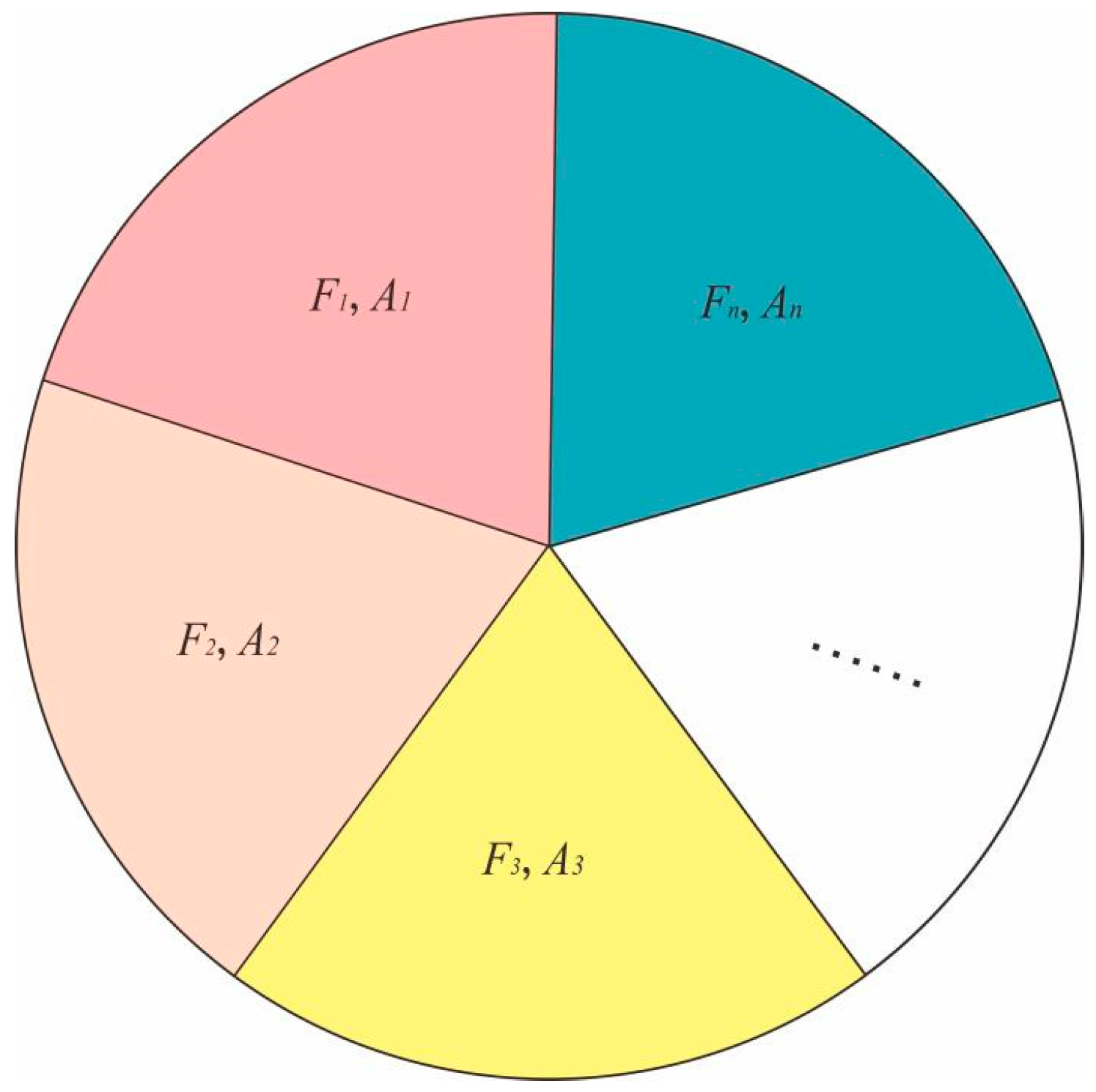
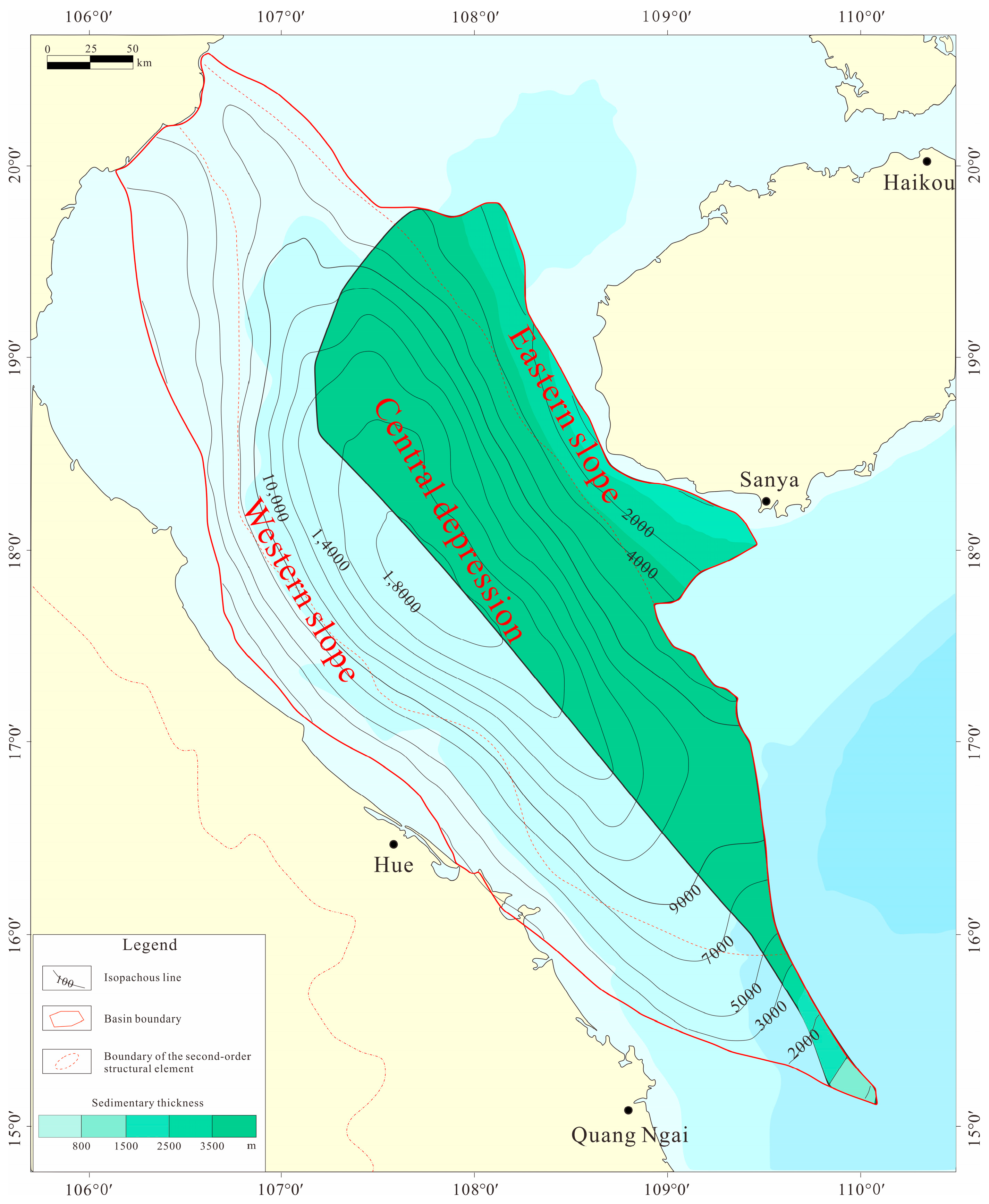
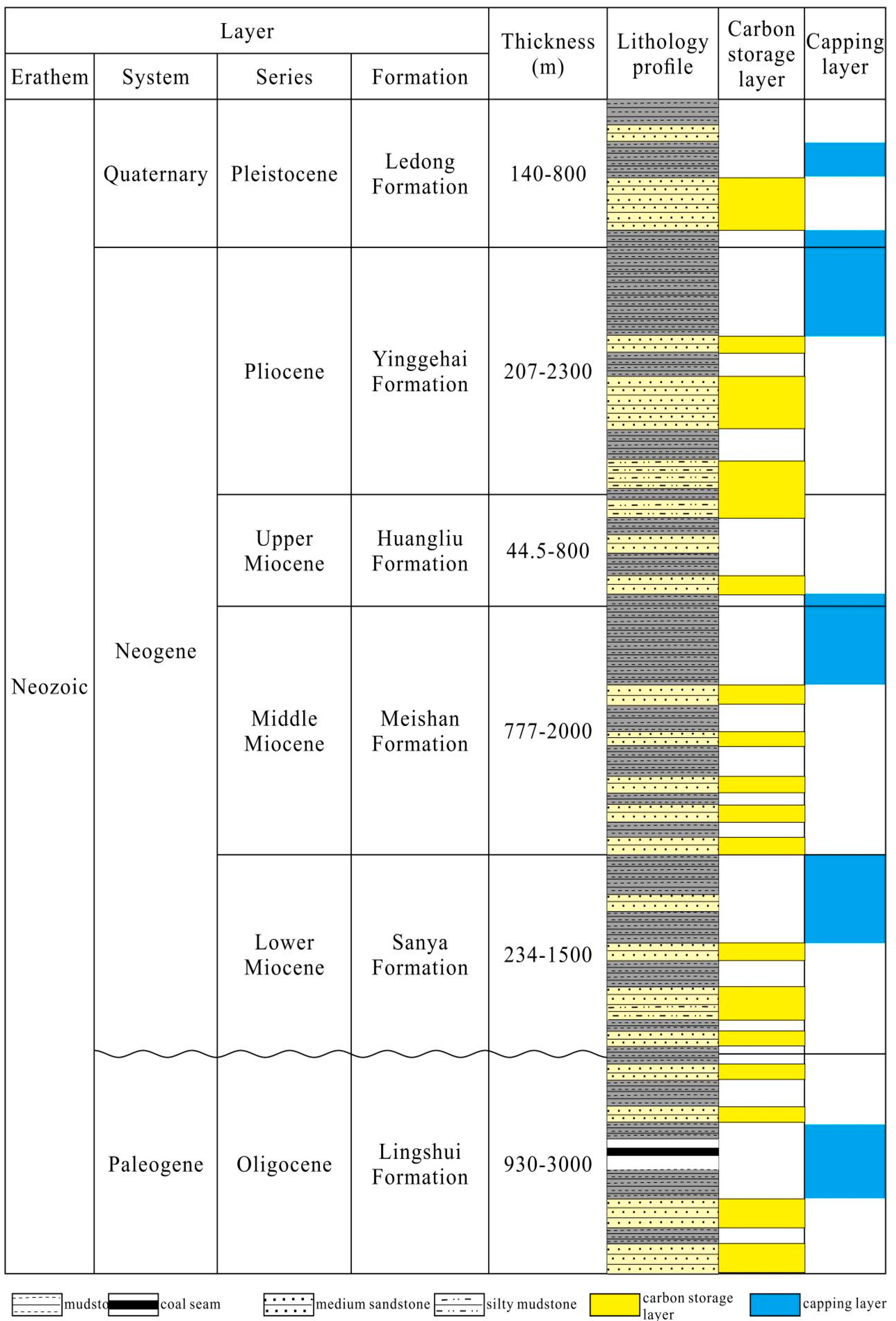

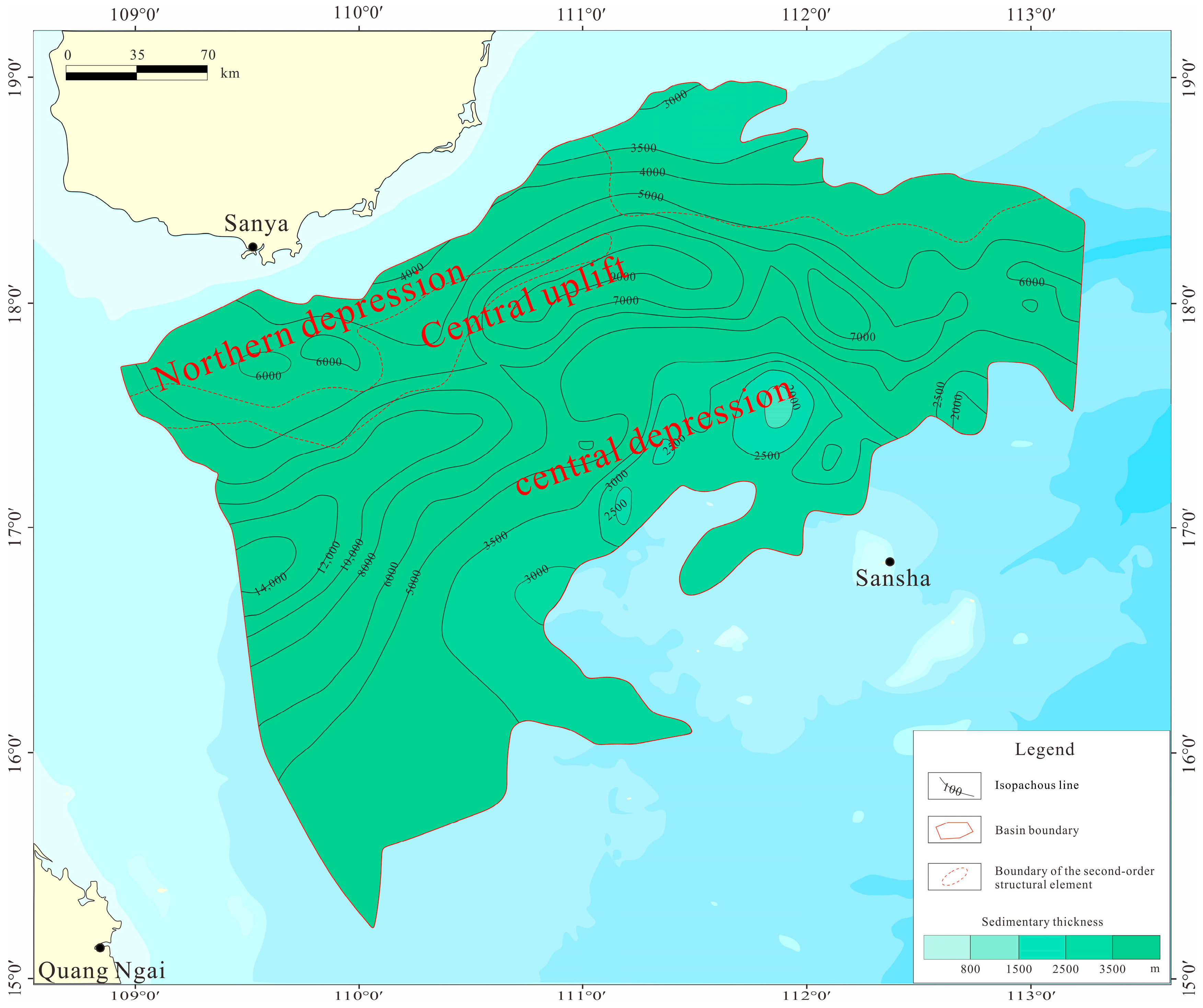


| Evaluation Level | Applicable Conditions | Estimation Method |
|---|---|---|
| E | Basin level | Mechanism Method (Forum Geological Work Group) [22] Volumetric Method (U.S. Department of Energy Geological Task Force; U.S. Geological Survey) [19] |
| D | Zone level | Mechanism Method (Forum Geological Work Group) Volumetric Method (U.S. Department of Energy Geological Task Force; U.S. Geological Survey) |
| C | Target district level | Mechanism Method (Forum Geological Work Group) Volumetric Method (U.S. Department of Energy Geological Task Force; U.S. Geological Survey) |
| B | Site level | Mechanism Method (Forum Geological Work Group) [23,24] |
| A | Perfusion level | Mechanism Method |
| Indicator Level | First-Level Indicators (Basin Weight/Zone Weight) | Second-Level Indicators (Basin Indicator Weight) | Second-Level Indicators (Zone Indicator Weight) | Description |
|---|---|---|---|---|
| Necessary Indicators | Sequestration Potential (0.3/0.4) | Basin Area (0.05) | Zone Area (0.1) | The area of the basin/zone projected onto the plane. |
| Basin Thickness (0.05) | Zone Thickness (0.1) | The thickness of Cenozoic strata buried between 800 and 3200 m in the basin/zone. The thicker the strata, the more favorable it is for CO2 geological sequestration. The burial depth also affects the implementation conditions. | ||
| Sequestration Potential (0.1) | Sequestration Potential (0.1) | The predicted or presumed potential of the basin/zone for CO2 geological sequestration. The greater the sequestration potential, the more suitable it is for CO2 geological sequestration. | ||
| Per Unit Area Sequestration Potential (0.1) | Per Unit Area Sequestration Potential (0.1) | The potential amount of CO2 that can be sequestered per unit area in the basin/zone. | ||
| Geological Conditions(0.3/0.3) | Exploration Degree (0.1) | Exploration Degree (0.05) | This reflects the level of knowledge and data richness of the sedimentary basin/zone. The higher the degree of exploration, the more reliable and accurate the evaluation indicators become. This is beneficial for accurately assessing the suitability of CO2 geological sequestration in the sedimentary basin/zone. | |
| Seafloor Temperature (0.05) | Seafloor Temperature (0.05) | The average temperature of seawater at the seabed. The temperature of seawater has a certain impact on geothermal energy. For a marine region, the temperature of the seafloor primarily depends on the latitude and water depth, and the average value over multiple years is considered. | ||
| Geothermal Gradient (0.05) | Geothermal Gradient (0.05) | Expressed as the number of degrees Celsius (°C) of temperature increase per 100 m of vertical depth. This indicator reflects the rate of temperature increase within the strata with depth and is one of the important parameters that affect the potential of CO2 geological sequestration. The geothermal gradient is determined by the Earth’s internal heat and the thermal conductivity of the strata. | ||
| Fault activity (0.1) | Fault Activity (0.05) | Divided into three categories: inactive faults, faults without through-going faults, and faults with through-going faults. | ||
| Reservoir Conditions (0.05) | Based on the size of porosity, the reservoir carbon layers are divided into three categories: high-quality, good, and effective carbon storage layers. | |||
| Cap Rock Conditions (0.05) | Cap rocks are classified based on their thickness and scale. | |||
| Engineering Conditions (0.4/0.3) | Development Degree (0.1) | Development Degree (0.1) | This reflects the extent of oil and gas development in the basin/zone. The higher the level of development, the more advanced the drilling platforms and pipeline network become, leading to better engineering conditions. | |
| Offshore Distance (0.1) | Offshore Distance (0.1) | The shortest distance from the basin/zone to the coast. The farther the distance, the higher the transportation and injection costs, the greater the technical difficulty, and the less favorable it is for CO2 geological sequestration. | ||
| Seawater Depth (0.2) | Seawater Depth (0.1) | When the depth of seawater exceeds 150 m, more sophisticated and costly platforms and processes are necessary. The greater the depth, the higher the technical difficulty, and the greater the cost. | ||
| Key Indicators | Seismic Belt | Based on the occurrence of earthquakes above a magnitude of 8 in a basin or zone over the past century, it is divided into seismic belts. If the condition applies, a value of 0 is assigned; otherwise, a value of 1 is assigned. | ||
| Drilling Engineering Feasibility | The feasibility of drilling engineering is primarily determined by whether oil and gas drilling projects have been implemented in the basin or zone. If there is no oil and gas drilling, this indicator is assigned a value of 0; otherwise, it is assigned a value of 1. | |||
| Basin and Zone | Geothermal Gradient (°C/km) | Seafloor Temperature (°C) | Water Depth (m) |
|---|---|---|---|
| Yinggehai Basin | 40 | 24 | 50 |
| Central Depression | 36 | 24 | 50 |
| Eastern Slope | 39 | 24 | 50 |
| Western Slope | 39 | 24 | 50 |
| Basin and Zone | Geothermal Gradient (°C/km) | Seafloor Temperature (°C) | Water Depth (km) |
|---|---|---|---|
| Qiongdongnan Basin | 40 | 5 | 1 |
| Central Uplift | 39 | 15 | 0.15 |
| Central Depression | 40 | 5 | 1 |
| Northern Depression | 37 | 20 | 0.1 |
| Level | Basin and Zone | Area (within National Boundaries) km2 | Porosity | Sand-to-Shale Ratio | CO2 Density (kg/m3) | Effective Sequestration Potential of Basin/Zone (×108 t) | Sequestration Potential per Unit Area (×104 t/km2) | ||
|---|---|---|---|---|---|---|---|---|---|
| E1 = 1.2% | E2 = 2.4% | E3 = 4.1% | |||||||
| Basin Level | Yinggehai Basin | 46,929 | 0.11–0.29 | 0.3 | 263–518 | 303 | 606 | 1036 | 129 |
| Zone Level | Central Depression | 35,273 | 0.31 | 289–560 | 273 | 546 | 932 | 155 | |
| Eastern Slope | 10,437 | 0.29 | 269–528 | 66 | 131 | 224 | 126 | ||
| Western Slope | 1218 | 0.29 | 269–528 | 7 | 13 | 22 | 108 | ||
| Basin Level | Qiongdongnan Basin | 96,289 | 0.18–0.26 | 0.32 | 678–822 | 1307 | 2615 | 4467 | 272 |
| Zone Level | Central Uplift | 13,119 | 0.34 | 415–573 | 133 | 265 | 453 | 202 | |
| Central Depression | 71,466 | 0.3 | 678–822 | 972 | 1943 | 3320 | 272 | ||
| Northern Depression | 11,704 | 0.34 | 353–568 | 70 | 140 | 240 | 120 | ||
Disclaimer/Publisher’s Note: The statements, opinions and data contained in all publications are solely those of the individual author(s) and contributor(s) and not of MDPI and/or the editor(s). MDPI and/or the editor(s) disclaim responsibility for any injury to people or property resulting from any ideas, methods, instructions or products referred to in the content. |
© 2024 by the authors. Licensee MDPI, Basel, Switzerland. This article is an open access article distributed under the terms and conditions of the Creative Commons Attribution (CC BY) license (https://creativecommons.org/licenses/by/4.0/).
Share and Cite
Tian, Y.; Du, Z.; Zhang, L.; Zhang, L.; Xu, G.; Chen, J. Research on Evaluation of the Carbon Dioxide Sequestration Potential in Saline Aquifers in the Qiongdongnan–Yinggehai Basin. J. Mar. Sci. Eng. 2024, 12, 997. https://doi.org/10.3390/jmse12060997
Tian Y, Du Z, Zhang L, Zhang L, Xu G, Chen J. Research on Evaluation of the Carbon Dioxide Sequestration Potential in Saline Aquifers in the Qiongdongnan–Yinggehai Basin. Journal of Marine Science and Engineering. 2024; 12(6):997. https://doi.org/10.3390/jmse12060997
Chicago/Turabian StyleTian, Yukun, Zhili Du, Lin Zhang, Lizhong Zhang, Guoqiang Xu, and Jiaojiao Chen. 2024. "Research on Evaluation of the Carbon Dioxide Sequestration Potential in Saline Aquifers in the Qiongdongnan–Yinggehai Basin" Journal of Marine Science and Engineering 12, no. 6: 997. https://doi.org/10.3390/jmse12060997
APA StyleTian, Y., Du, Z., Zhang, L., Zhang, L., Xu, G., & Chen, J. (2024). Research on Evaluation of the Carbon Dioxide Sequestration Potential in Saline Aquifers in the Qiongdongnan–Yinggehai Basin. Journal of Marine Science and Engineering, 12(6), 997. https://doi.org/10.3390/jmse12060997





